Welcome to the last day in the Story Grammar Marker series. Today’s post is my favorite! It’s on Story Grammar Marker: Personal Ideas! Again, the best part about SGM is it’s flexibility. While the manuals make recommendations and others have their own ways of teaching/implementing, you should feel free to dive in, try different things, and see what works best for you and your students! I’m certainly not an expert and am always learning, but I detailed some ideas below that I’ve found helpful in my years of using Story Grammar Marker.
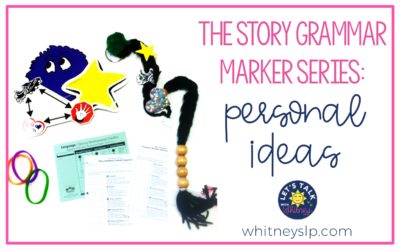
Organizing & Displaying SGM Materials:
I would be remiss if I didn’t include my SGM team from St. Petersburg, FL! For Halloween, we decided to bring Literacy to Life by dressing up as The Paper Bag Princesses! These girls were around when I was first starting out as a little baby SLP. We learned from each other, encouraged each other, and had a tremendous amount of fun. Even though we don’t work together anymore, they’ll always be my SGM team!
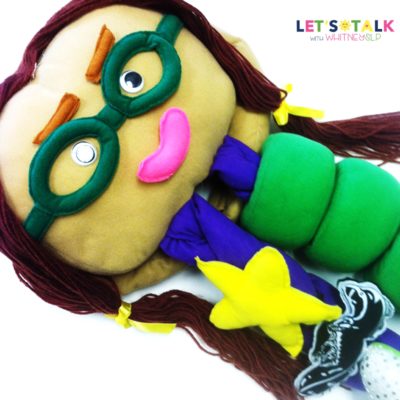
This is a science fair board covered in felt. The icons stick to it nicely, which helps to store all of my “extra” Braidy pieces not being used at that time!
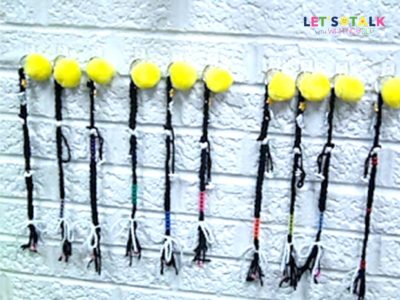
The student story braids hang on Command hooks on my therapy room wall. The students know that when they come in the classroom, they should grab a story braid before sitting down!
We made this bulletin board when we first started learning character and feelings. I found body part stickers, and the students chose different facial expressions for their characters!
I also have an “SGM Station” in my room, where I keep all of my SGM materials together in one place. This helps me keep everything I need at my fingertips!
A few extra tips:
- Once you really get into SGM, you may find that you are having a hard time navigating around the different teaching manuals. There are so many worksheets (which is not a bad thing), that sometimes it’s hard to remember which ones you have and where to find them. Because of this, I spent time making a copy of the worksheets I use and organizing them into my personal teacher binder. I organized them by icon (character, setting, kickoff, etc.) This way I can choose which worksheet to use for different kids, depending on their ability levels.
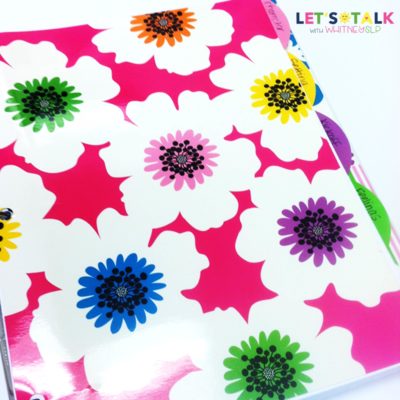
- I get asked all the time about which books I choose for SGM. I’m a serious children’s book collector, but following is a list of some of my favorites for the months of the year. I linked any book companions I have for them as well.
- January-Pierre the Penguin by Jean Marzollo
-
February-Somebody Loves You Mr. Hatch by Eileen Spinelli
-
March-Lucky Tucker by Leslie McGuirk
-
April-Pig’s Egg by Katherine Sully
-
May-The Rainbow Fish by Marcus Pfister
-
September-Pout Pout Fish by Deboroah Diesen
-
October-Room on the Broom, by Julia Donaldson
-
November-Turkey Trouble by Wendi Silvano
-
December-Just A Snowman by Mercer Mayer
-
Use the Data Sheets! They help you know exactly where to start on each kid, and exactly what areas you need to spend more time on. (And exactly how far the kiddos have come!)
-
Utilize the SGM blog on Mindwing Concepts for additional ideas.
-
Get other teachers involved! Carryover into the general education classes is key!
-
Be creative! You can print pictures from stories and velcro them on Braidy, make sequencing visuals for story retell, use the magnets, stamps, and just about anything else to teach SGM!
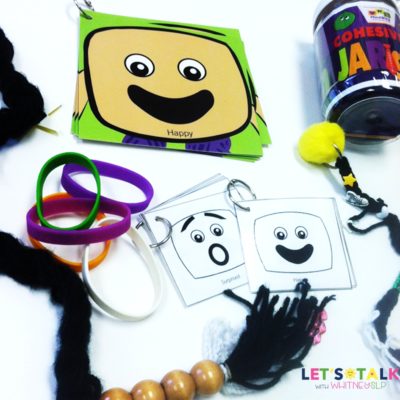
I hope you enjoyed today’s post on Story Grammar Marker: Personal Ideas! For more information on Story Grammar Marker and related products, visit MingWing Concepts. If you missed the previous posts, you can click the link below to see the first post in the series:
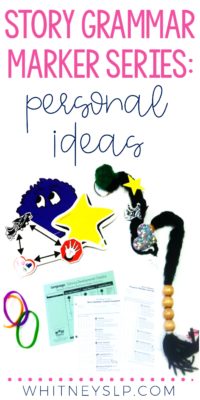

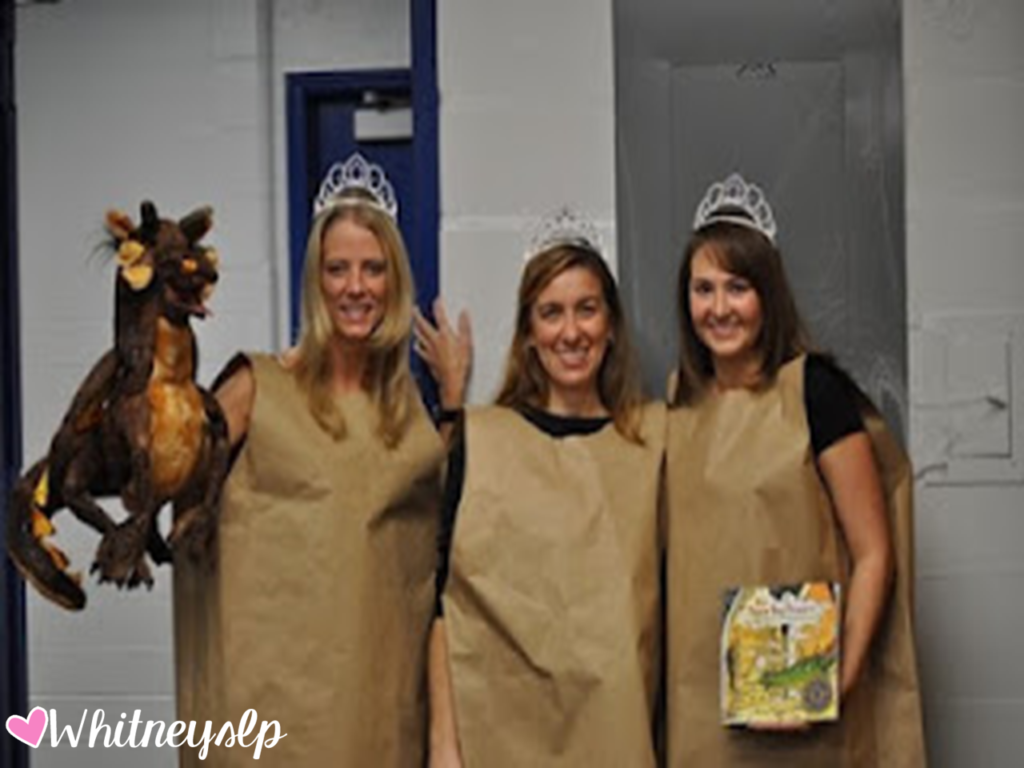
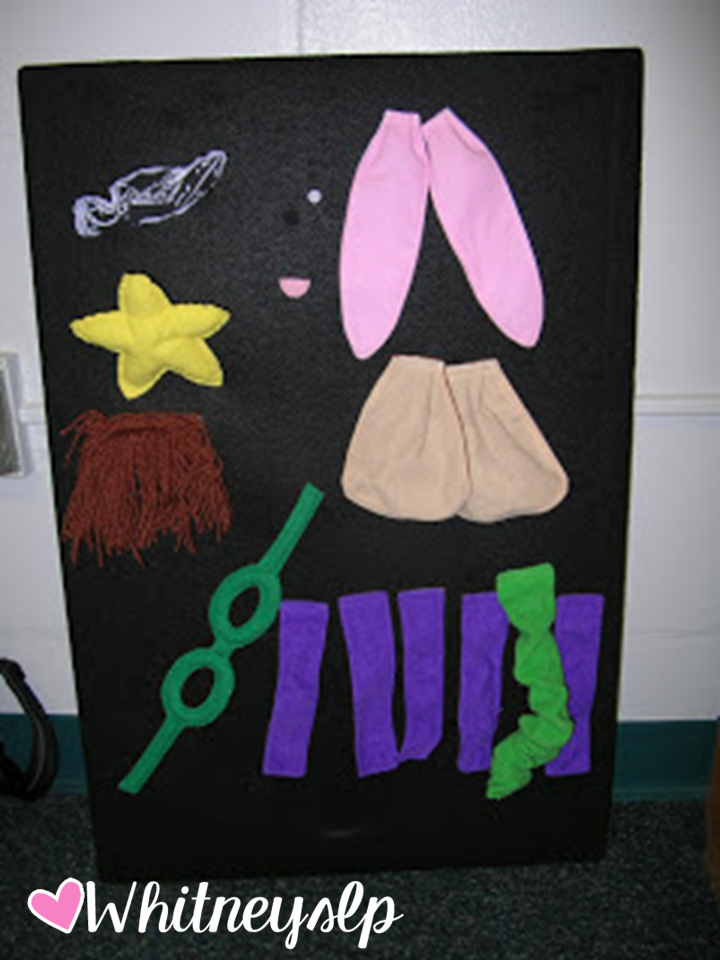
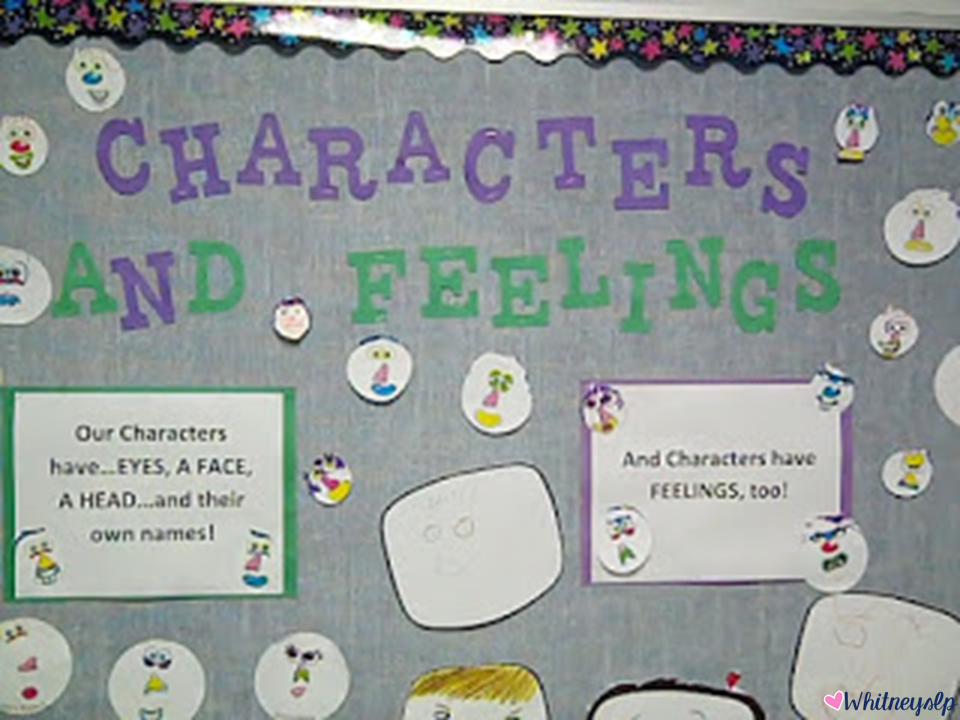











I love using Braidy in therapy. I don't use SGM as much because I only work up to 2nd grade with just a few 3rds…
I really like your idea of creating a seperate binder with the worksheets I use most often. Thanks so much.
Tai Patrice
Thanks for your comment! For me personally, creating my own binder for worksheets makes SGM much easier to teach for the different ability levels! ~Whitney 🙂
Hi, I'm your newest follower! I have never heard of Braidys, but I LOVE them! I also like your month-by-month break down of books. You've got some good titles on there!
Thanks!
Let's Talk Speech Therapy
Rachel
Hi Rachel! Thanks for following! Braidy is definitely worth the investment if you're ever interested! My kids love him and have made such progress! Thanks for sharing your link, too! ~Whitney 🙂
Hi Whitney-
I have just found and read through your entire blog tonight- and love it!! I am entering my first full year working in the schools (graduated last December) and am still trying to figure out my way- I am in a Pre-k through 5th grade school, with two self-contained autism classes. At the end of the year last year I got my district to purchase me the Braidy story Kit and the Story Grammar Kit. I had heard great reviews of them, and felt like I was in need of some sort of guidance/EBP of how I could be more of a "push-in" therapist, and be connected more to the curriculum/CCSs. I was thrilled to get these, and am so excited to start using them- but have yet to be formally trained. I am going to try and ask for a PD on these programs, but have a feeling I will be teaching myself most of it starting out. I was hoping I could ask you a few questions though-
a.) Do you use Braidy for Pre-K through 1st, and Story Grammar for 2nd-5th?
b.) How did you first start out using the programs in your school? Did you collaborate with one teacher, grade, etc? Or just start out using it in Speech Tx pull out sessions?
c.) In terms of data- I do not have the new data collection manual; Should I beg to get this or do you think the pages in the teacher's manual(s) would be enough?
d.) Are you actually able to use these programs with some of your more severe ASD cases (e.g., students who would typically receive more of an ABA approach?) or just for your more higher functioning (Asberger's) kiddos?
Hope this isn't too overwhelming- You're blog provided me with some GREAT information regarding the SGM program- but anything additional you could let me know would be really appreciated. Thanks so much 🙂
-Stefanie
..
Hi Stefanie! Thanks so much for reading the blog AND your questions. If you ever get the chance to take the formal training under Mary Ellen Moreau, I highly recommend it. However, by working through your manual and jumping right in, you will be able to do just fine!I am going to try and answer your questions in the order you asked:
a) I typically use Braidy for Pre-K-1st grade and the story braids with grades 2nd-5th. However, this is not always the case. I use Braidy with all of my students in the self-contained Autism classrooms (grades K-3). We just got a new self-contained Autism classroom this year for grades 3-4, and I will probably start off with Braidy and transition to the story braids. I also always show Braidy to all the kids regardless of grade or ability when I am introducing SGM. I like to show them how Braidy goes along with the story braids so they can see a "bigger picture."
b) When I first started using SGM, I only used it with my pull-out students and those students in the self-contained classrooms. I wanted to make sure I could teach it to them before I taught it to the other teachers. Then one of the 4th grade teachers asked me to do a mini lesson in a 4th grade team planning meeting. They were preparing their students for FL Writes and wanted ideas to use with the struggling students. They loved the program and began using it some in their classrooms. And it kind of kept going from there…Not everyone in the school uses SGM yet, but that's my goal! 🙂
c) As far as data goes, if you have the ability to get your hands on the data kit, it's worth it. However, I used SGM for over a year before I took the data training and got the data kit, so it's definitely do-able. The data kit just has additional data sheets and ideas for data collection. As long as you're taking some kind of data so you can see what areas your kids need to focus on and how they are progressing, you're good to go. Data is data 🙂
d) I pretty much use SGM with ALL of my students. I have even been known to use SGM with artic students working on carryover. (I try to do a lot of language-based artic therapy.) It it my opinion and experience that all kids, no matter how involved, can be successful with SGM. I have several Autistic students that are more severe who can tell me that Braidy is a character and characters have eyes, a face, and a head! It may take them longer to retain the material, but they can do it. It also works great with teaching them about feelings too-they love to physically change his expressions and match the expression on their own faces. Have them to identify feelings both expressively and receptively! I also have higher functioning students who can go further with the program. For the students with Autism, I teach one icon at a time and stay there until they have mastered it. I really don't have a specific timeline. We may stay on character for 2 weeks, and setting for 2 months! The best advice I can give you is to be creative, flexible, and more than anything, make it fun!
Please let me know if you have any more questions. I'm happy to help!
~Whitney 🙂
Wow- Thanks SO much for the wonderful response!! You're really getting me excited and inspiring me to use this program. A couple more questions if you don't mind (!):
a.) How do you schedule the books? Do you do one book per week/month etc? And do you typically use a different book for each grade level? Some of my kids are only a half hour a week so I'm just wondering how I'm going to do this so that we have time to actually read the book together, let alone work on the retell.
b.) Are there specific pages in either the Braidy teacher manual or the Story Grammar manual that you suggest me using to track data? And do you have any suggestions of good books to use for baselines??
c.) Just curious- around how many kids are on your caseload?
Thanks again Whitney!
-Stefanie
Hi Stefanie- Here you go…
a) How long I spend on each book depends on the group of kids and how long it takes us to finish it. When I realized that I did not have to rush through a book each therapy session, but can take my time and stay on a book as long as I wanted, it was such a relief! When I am first starting to teach the icons, we may read through a different book each session just to pick out the character or setting, or whatever icon we are learning at that time. But as the students begin to put everything together and retell stories, we may stay on the same book for 3 weeks or more! This is especially the case with the older kids. I generally try to keep the same book for each grade level because it's easier on me, but it doesn't always work out that way. For Pre-K, I try to follow along with their classroom themes. I try to use the SGM Book of the Month for as many groups as I can (even if I make it more simple for the younger grades). I have several 4th and 5th grade groups doing chapter books! You can set the timeline. And I don't get all out of whack if I need to stay on a book a little longer, or if we are finished with it quicker. We also read through shorter books several times over the course of several sessions!
b)In the Braidy Manual, I use the Teacher Analysis Sheets (both macrostructure and microstructure). These are found on pages 160-161 in my manual. I also use The Braidy Progress Monitor & Instructional Planner (p. 63)and the Braidy Quarterly Data Collection & Progress Monitoring sheet. For SGM, I use the Teacher Analysis Sheets (macrostructure & microstructure) pages 55-56 in my book. I use the SGM Language/Literacy Developmental Checklist also.
c) In total, there are about 75 kids receiving speech/language/social services under the SLP at my school. In addition to me, there is another full-time therapist as well. We maintain about 40-45 kids each (some of the kids have lots of minutes, so we both see them). Our school has three self-contained ASD classrooms, 2 blended Pre-K classrooms, and a self-contained EBD classroom.
Let me know if you need anything else!
Whitney 🙂
Whitney-
Thank you so much! You are a wealth of great information and I REALLY appreciate the detailed responses. We actually had a speaker on Autism today for a PD (an SLP) and she specifically brought up the SGM as an effective intervention program:)
Last quick question (promise!!): Any advice on books you find to be the best for baselining each grade?
Thanks again,
Stefanie
Stefanie-Don't promise no more questions! I really appreciate them. Hopefully someone else is learning from your questions as well!
Last year, our county (Pinellas) gave all the SLPs working with SGM two different books to use for baseline: Big Al, by Andrew Clements, and The Paper Bag Princess, by Robert Munsch. Both of these books are (at least) one complete episode and have all of the story elements included. They asked that we not teach these books during the year, but use them for baseline data purposes instead. They both worked great for all age groups (minus maybe Pre-K). Your developmental charts will tell you what is expected for each grade level. Big Al is wonderful to use because it has a sequel also: Big Al and Shrimpy. Last year, I used Big Al first, and then Big Al and Shrimpy for the mid-year baseline. Other books I love to use for baseline are the books I chose for the SGM Book of the Month. With these, I take baseline data on the story retell, and then teach the book afterwards. I typically try and take baseline data 4 times per year on each student. The quarterly data chart has room for 4 story retells. I do one at the beginning of the year before I have taught SGM at all, one right before Christmas break, one around February/March, and one at the end of the school year. There are also great suggestions for books in the back of your SGM and Braidy manuals. I like to choose books that are a complete episode for story retell baseline data, even if I don't expect that child to include all of the elements. They may surprise you!
Hope this helps!
Whitney 🙂
Realized I never wrote back to this post, but want you to know how helpful it's been. Thanks again! -Stefanie
Hi Whitney! I am loving your blog! I am at different school this year and a lot of the students have goals to listen to a story, sequence the pictures, answer wh questions and then retell the story. The previous SLP used SGM and braidy so I am trying to learn the program so I am very thankful for your blog! Just wondering how you struction your therapy sessions, trying to get through all the sequencing, answering wh and retelling is too much for a group of 3 and 30min! Also, can you give some examples of your students goals? THANKS!
Hi Mallory. Thanks so much for your questions! I think the beauty of SGM is that you can do as much, or as little as you need to for each lesson. When I'm first introducing SGM, I don't worry about trying to get all of their goals in and take data on every single thing. I may teach character and we may talk about and answer questions about the character (wh questions) one day, and work on story sequencing the next. I often times choose a story and stay on that story for multiple lessons while we target all of the goals (wh questions, retell, sequencing, etc.). Sometimes, depending on the need, the age of the students, and the length of the story, I may stay on one book for a few weeks! Many of my students' goals are similar to yours. Some of them that were written specifically for SGM might read something like, "So-and-so will identify story elements, such as character, setting, and the kick-off with 80% accuracy," or "So-and-so will orally retell a story including all story elements in the correct sequence with 70% accuracy." Does this make sense?
Let me know if you have any more questions!
Whitney 🙂
Hi Whitney,
Just came across your blog…and LOVE all of the SGM info. I am just getting started….I have the manual, a few student braids and the teachers manual. I do have a few question..
1. When you do your baseline and quarterly assessments, do the students do a story retell with the book/ pictures available to help facilitate or no book/ strictly from recall?
2. Please list the "must have" materials…I work in a typical S-L kindergarten- 5th grade elementary. Mostly pull out, some push in ( doing 3:1 service model delivery ). I am hoping my district will help purchase more Mindwing products. I was thinking about Braidy and Storybraid manual. Not sure I need the entire kit? But I do like the posters and visuals for SGm and Braidy.
Thanks much in advance for your reply.
Susie
Hi Susie! Thanks so much for reading! I'm so glad you are finding the information useful. Here are my answers to your questions:
1. When I do my baseline and quarterly assessments, I read the book to the students and show them all the pictures. Then I take the book away and have them to retell as much as they can remember. I realize that many of my students (especially those in the ASD classrooms) are able to recall much more of the story if they can see the pictures, but I want to see what they can do without the visuals first. Many of my students are working on story retell with visuals first, and the eventual goal is to have them retelling the story by memory.
2.) Must have materials: I am fortunate to have most everything in the Mindwing collection. Our district has really adopted the SGM materials and have been wonderful with providing those of us who have taken the different trainings with all of the materials. Because the majority of my caseload is ASD, I have the ASD set which I love. It goes in more depth with perspective taking, feelings, and social skills. If you work with Pre-K/Kindergarten, you definitely need Braidy and the Braidy manual. It is set up more for younger kids and the worksheets are easier for them to do. If I show up in Pre-K without Braidy, they want to know where "my friend" is! I also use Braidy with my ASD kids as opposed to the story braids. I do use the bracelets, velcro strips, and stamps a lot, but they are not must haves to use SGM, just added luxuries! The last "must haves" are books, books, and more books! I love books anyway, but after starting SGM, I'm pretty much obsessed. I will sit in Barnes and Noble for hours looking for books in the different stages. When you find a good book for a complete episode, grab it quick!
Good luck, and let me know if you have any more questions! Most importantly, have fun with it. The kids LOVE it!
Whitney 🙂
Than you for the info. I have the SGM manual and am looking at the Braidy manual. Do you have both manuals? If so, is the info the same/worth purchasing? Again, thanks for your reply.
Susie
Hi Susie. I do have both manuals. I also have the Autism manual as well. Having the Braidy manual is definitely worth it. It has lots of info, lesson suggestions, and printables geared for the younger crowd. I also use Braidy for my Autism classes instead of the story braids. If you have a chance, the Autism collection is also wonderful.
Whitney 🙂
Hi Whitney!
So I just found your book of the month for November..Turkey Trouble..and am so excited to use it! However, I was hoping to pick your brain a bit more with questions. I'm finding with- say my 3rd-5th graders- I'm running into kind of a rut. I'll read the story to them, see if they can identify the SGM parts, push for the transition and conjunction words, and then I just have them write it out to really pick at the microstructure… are there any other little tips you could share that you find you're focusing on a lot with these grades? Also, I"m finding with say my 3rd graders…if they were at, for example, the reactive stage…I would rather jump and get them to a complete episode by always having them including the plan, internal respons and resolution rather than just not addressing these. What do you think?
I'm really trying to stay strong with using Braidy/SGM but I'm finding a couple things discouraging me: 1.) Trying to figure out what stage books are 2) Trying myself (!) to identify what the SGM parts are and 3.) How to keep it all engaging for my students.
As always, any help you can share would be appreciated!
Thanks so much!
Stef
Hi Stef! Thanks again for your great questions. I'm not sure all of my answers are "official SGM answers," but I'll just share my opinion! First of all, you will love Turkey Trouble. It is so cute and one of my favorite stories to teach all year! I understand about sometimes getting into a rut. In order to avoid those times, I try to do additional activities for each story instead of just reading the book and having the students retell the story. For instance, we might do a writing activity or craft inspired by the story. (For Pierre the Penguin, we make penguins, for Turkey Trouble, I have the students write a plan on how they would keep themselves safe if they were a turkey on Thanksgiving (their plan has to be different than in the book.) As for jumping your kiddos from the reactive stage to a complete episode stage, I do that all the time! The complete episode or more is the eventual goal, so if they can handle it, jump on! For your questions, this is what I would suggest:
1) If I have trouble identifying the stage, I use the breakdown chart from the manual (teachers checklist). I try to write down the parts myself to see where it leaves me. I'm not always right either, so don't be too hard on yourself! I utilize my colleagues for help too!
2) I sometimes ask my colleagues about this, too. I also try to use some of the charts in the manual to help breakdown each piece.
3.) To keep it engaging, I try to take my time really analyzing each story element, using the worksheets, diagrams, etc. I also use crafts and writing activities too. And there is also an SGM game set that comes with the Autism kit that the kids love. You can order the game set seperately, also.
Hope this helps. Let me know if you have more questions, or if it something doesn't make sense!
Whitney 🙂
Hi Whitney,
I just got both SGM and Braidy manuals. As I am plowing thru them, I have a quick question…..
When you do your baseline, what age do you use the book Paperbag Princess, Big Al ect? Do you use these books for baseline assessments all the way down to kindergarten? Or do you have another book(s) that you use with the younger kiddos?
Thanks again for your reply!!!
Susie
Hi Susie! I try (key word, "try") to take baseline data before I ever start teaching SGM to the kids. This way, I can track where they were before SGM, and how far they have come. I typically take baseline 4 times per year (I use the baseline data sheets that come in the manual-they have space for four different data collections per student per page.) I also use a different book for each data collection. This way they have not been taught the book and the data is more valid. I do have colleagues that use the same book for data collection, though. Also, I teach the book after I take data, so the kids understand what I want them to do. It's amazing to see how much more they include in the data collection #4 than in #1!
As for which books I use, it varies. I have used Big Al with kindergarten students, but not the Paperbag Princess. I try to choose books that are on their level, and that have the components in them that are expected for the students of that age to know. (i.e. I wouldn't expect a Kindergarten student to explain a complete episode on the first data collection day.) I have also used familiar stories with the really young kids (i.e. The Three Little Pigs). They are somewhat familiar with the story, but if they are delayed in their story retell, they will still leave major parts out because they assume you know them already!
Hope this helps. Let me know if you have anymore questions!
Whitney 🙂
Hi Whitney,
I just found your blog and thank you for all the helpful advice regarding SGM. I'm actually thinking of ordering Braidy or SGM manual and not sure which one to purchase (I'm buying it on my own with a limited budget). Can you guide me as to what's the most crucial to spend on? I have a 6 year old student with difficulties in word retrieval, story retell (narration), and syntax. His stories are often choppy and lack content. He also struggles with critical thinking (very literal). Would this program help me? If so, which manual am I better off purchasing? Also, can I use the story grammar marker doll with the Braidy manual? The braidy doll is pretty expensive? Additionally, I also have a 5th grade student with theory of mind issues (I have been working with her using Michelle Winner's products). She struggles with narration -leaves out the background information in a story. Would SGM help her??
Any advice would be greatly appreciated. Thank you so much!
Hi Rachel! Thanks so much for reading the blog. I'm so glad you found in useful! In case you haven't noticed, I'm a HUGE SGM fan! The best part of SGM is that it is so flexible. You can use it in so many different ways for so many different students! I would normally tell you to choose which book to buy based on the ages of your students. (I use the Braidy manual for the younger students and my students in the Autism classes and the SGM manual for my older students.) But if I had to advise you on one, I'd say get the SGM manual. It can be modified to make it easier for your younger students, and many of the things in the manuals are similar or the same to the other. You can most definitely use the story braids with the Braidy manual or the Braidy doll with the SGM manual…it is really that flexible! As for the two students you mentioned, SGM sounds perfect for them! You will be so surprised at how many different ways you can use it. To name a few, we work on identifying the story elements, story retell, vocabulary, describing, grammar, complete sentences, perspective taking, social skills, planning, inferencing, predicting, sequencing, wh questions, and much, much more!!! If I were you, I'd start off by purchasing the SGM manual and a set of the story braids. Plan on spending some time diving into the manual-there's a lot there. And don't be afraid to just jump right in with teaching it…there really is no wrong way! If you need any help or have any questions along the way, let me know. I'm happy to offer my advice (for whatever it's worth!) 🙂
Good luck!
Whitney 🙂
THANK YOU FOR YOUR HELP!! I'm so glad I found your blog. I really appreciate your advice and willingness to help. I've also found your response to others very beneficial. Just to clarify, the 6 year old I'm working with can benefit from SGM? He's young, but really needs work on narration, organization, creativity, and SYNTAX. The SGM can help me with that, right?? Thanks again, you are too kind!
You are so welcome! Yes, your 6 year old student can most definitely benefit from SGM! I even use SGM with my Pre-Kers! If I ever show up to do a language circle without Braidy, they are asking where he is! No matter how young, they can learn the story elements and how to tell a story…they love the visuals. I sometimes take pictures of the different parts of the story we are reading and velcro them to that part of the Braidy doll (i.e. if we are reading a Franklin book, I velcro a picture of Franklin on Braidy's face, and a picture of Franklin's classroom to the star for the setting) so they can remember the specific elements to that story. They love it! SGM is great for teaching Syntax also…keep me updated on how he is doing!
Whitney 🙂
I will, thank you! I plan to order today. I think there is a 20% off coupon:). I just want to make sure, between the two, I am better off ordering SGM over Braidy? Would SGM help with narration (telling about his day) as much as Braidy?. Sorry, to make you crazy, I'm just not sure which of the two to order. I can only afford one. I am also ordering the SGM doll. sounds right?
Hi Rachel, you're not making me crazy at all! Doing research before spending that kind of money is always a good idea! Whether to order SGM or Braidy is really a judgement call. If you think you'll be using it more with older kids, order the SGM manual, and you can simplify it for the younger kids. If yout think you'll be using it more with your younger kids, order the Braidy manual, and you can make the lessons harder for the older kids. Either way, you really can't go wrong. The lessons and worksheets are similar, they just go along with either the Braidy doll or the Story Braids. There really isn't a "doll" for SGM. They are called story braids and you can order a teacher braid (a little bigger), or the student braids (smaller). Braidy is the big doll and he is used more for the younger kids. If I had to choose, I'd order the teacher story braid since your funds are limited. The older kids don't really like using the Braidy doll as much! Let me know if you have any more questions!
Whitney 🙂
Thank you so much for all your help!!
I hope you don't mind, I have more questions. Which posters would you recommend I order with the manual? or are they included in the manual?. I would also like to know ideally, would you recommend ordering both manuals or do they overlap and it's not necessary? I'm thinking to go with Braidy manual since my 6 year old really needs basic narration, but figured if it's really worthwhile I'll do both. Thanks again for your assistance with this. I truly hope it's not a bother.
Rachel, I really do not mind your questions at all! Collaboration is what this blog is all about…and your questions are sure to help others as well! I do not believe that any posters come with the manual if you order the manual by itself. If you order a complete set, I think the posters come with it. You can see exactly what comes in each set on the Mindwing website. Both manuals are nice to have, as they are somewhat different and have different printables. (The Braidy worksheets are more basic and the printing is bigger for the little kids). Each manual also has sample lessons and a list of books for each level in the back. You can get by with just one book, but if you had the option, I would recommend getting both. Tip: There is SO much information and SO many different worksheets in each book, that I couldn't wrap my mind around it all at once. I actually took several days to re-organize the books in the order that I teach SGM. I made copies of the worksheets I used the most, and organized them in my own teaching manual based on the story element (all character pages first, then setting, then kickoff, etc., and all assessment pages in the back.) Its just my personal preference, but may help you utilize all that is offered more effectively! Hope this helps!
Whitney 🙂
Thank you!!!! I really appreciate you took the time to answer my many questions. You have helped me so much, it was so nice of you.
I'm looking forward to receiving the manual.
Thanks again!
Rachel:)
thanks for share.
Thanks for the book suggestions. I ordered Just a snowman and its a great book. I am new at story grammar markers. Do you have a completed analysis form (main character, setting, initiating event, etc..) for this book? i would appreciate it.
Hi Sarah. I completed a "Complete Episode Map" on Just a Snowman last year. However, I only did the first episode in the story. If you remember, this story actually has a spin-off story at the end, when the characters make hot chocolate. I stopped after they finally built the snowman. One more note: This book is more than a complete episode, because there are conflicts to his original plan of building a snowman. For my younger kiddos, I read the conflicts (such as I wanted to build a snowman next, but so-and-so wanted to do…., but I don't include them so much in the story retell. For the older kids, we talk about the different conflicts. I did not include the conflicts here, but only the attempts to making a snowman. The Complete Episode Map is found on page 134 in my SGM Manual; however, it may be a little different in yours. This is what I have:
Main Character-Little Critter
Setting-at home, outside in the snow
Initiating Event (Kick-off)-It snowed, and school was cancelled.
Internal Response (Feeling)-Happy, Excited, Amazed, Thrilled
Plan: Build a Snowman
Attempt: Rolled a big ball for the bottom.
Attempt: Rolled a medium ball for the middle.
Attempt: Rolled a small ball for the top.
Attempt: Added eyes and a nose.
Attempt: Dressed it in a scarf, hat, and sunglasses.
Direct Consequence: He built his snowman (finally!)
Resolution: Proud, happy, impressed
Hope this helps! Feel free to let me know if you have anymore questions!
Whitney 🙂
HI Whitney,
Thanks for all your posts. I will definitely read through all of them so I dont ask all of the same questions. My district recently purchased the Braidy and SGM for me. However, I am extremely overwhelmed with implementation. I find the manuals extremely cumbersome to get through and am sort of winging it. I am thinking of putting it aside at this point until I can figure out the best way to implement it. I will keep reading your posts as I try to figure this whole thing out…but I wanted to let you know that I appreciate all of your information!
Thanks!
Alli
Hi Alli! Thanks so much for your comment. I can understand how you may feel overwhelmed. There is a ton of information in the manuals, and without having taken the trainings, I would probably feel the same way. I have been very blessed to have taken all of the trainings from MaryEllen; however, I too found the manuals difficult to wrap my head around. I think I mentioned this in one of my SGM posts, but after I took the trainings and before I began implementing SGM with my students, I took the manuals, made copies of the worksheets, etc., and re-organized them into my own teacher notebook that was a little bit easier for me to work with. I personally like the worksheets organized by icon in the order than I teach them. For instance, I start of teaching character, so all of the character worksheets are in one section of my notebook, then setting, then kickoff, etc. Then I have a section for writing and a section for assessment data. This allows me to see exactly what worksheets are available and not forget about them. Does this make sense? It might help for you to do the same thing. I would also try to read through the manuals if you get a chance, watch the videos on the mindwing website, check out the mindwing blog, read through my previous SGM posts, and if you ever get a chance, take the first SGM training. But most importantly, don't give up! MaryEllen and her team are very approachable and helpful. I'm sure they would be happy to answer any questions you have, as would I. There's really no right or wrong way to start implementing it. You'll learn as you go and perfect your implementation. The kids will love using the icons, and I'm sure you'll get more comfortable with it the more you use it. If you have any questions, I'm more than happy to try and answer them!
Whitney 🙂
Thanks Whitney! I really appreciate the help. I'll definitely do that…start by organizing my own notebook and go from there. Which is the first training…Braidy or SGM? I saw they were in Boston which isnt terribly far but not sure manageable for me right now. One question does come to mind…do you teach every icon independently first or as a reaction to a story? Also, can you recommend any easy/quick read stories to use it with for kids in second grade who are lower cognitively? Most of them know what each icon is by name at this point and they know character and setting. Thanks again for all your help!
Alli:)
Hi Alli! I'm not sure that there is really a "first" training, now that I think of it. I took the Braidy and SGM training at the same time, and I'm pretty sure that's how they all are. Think of the first training as a SGM overview. There are other trainings based on other materials, such as Data Collection, Autism, Write to Learn, and Common Core. I tend to teach each icon independently, including the icons that are expected for that age level. For instance, I wouldn't teach "kickoff" for Pre-K until they were absolutely ready to move on. It's just personal preference, but I like to explore a lot about each icon and practice identifying the different story elements in stories before we move to the next one. Once they have a general idea about the icons and story elements, we put them all together. I don't think everyone teaches it that way, but its just the way I tend to do it (and the way I have my teacher notebook set up). I did a past post on books I recommend for the different months, but right now, I would try to find the book Turkey Trouble. It is amazing for SGM and identifying the different story elements, and the kids love it. They can act it out, and its applicable to the upcoming Thanksgiving holiday. I just highlighted a companion packet I made for that book, and you can find that post on my blog as well. Let me know if you have any more questions!
Whitney 🙂
Once again…thanks for all of your help and information! I am beginning to reorganize my own binder as a start and will definitely look for your Turkey Trouble packet. Do you have any other Braidy/SGM story packets on TPT or anything? I would definitely be interested in seeing how you break down a whole book, the different lesson plans you use with each book (e.g. syntax, vocab etc), and any other lessons like crafts etc for a given book. Thanks! Alli
Hi Alli! You are very welcome! I have done several other book companion packets that work well with SGM. You can find them in my TPT store under the category Book Companion Packets, but a few of my favorites are:
Turkey Trouble
Room on the Broom
The Rainbow Fish
The Pout Pout Fish
Bear Feels Scared
I'm also working on several for Christmas as well which will be up soon! My TPT store address is: http://www.teacherspayteachers.com/Store/Whitneyslp.
Thanks! 🙂
Hi Whitney,
Thanks for sharing all of your wonderful knowledge on this blog. I will be doing SGM this year for the first time with my students in grades 2-5. I work at a school for students with dyslexia who all have average to above average cognition. Couple questions:
1. In the SGM manual it suggests beginning by doing a lesson on the meaning of each strand (pragmatics, semantics, etc.). Have you done this?
2. You mentioned that you like to begin with stories discussing each narrative component beginning with character, then setting, and so on. Do you have specific books you like to use for each of these?
3. I would love to take a training but the website does not have any listed. How did you find the trainings you attended?
4. I purchased the "East Meets West" book and although it suggests books for grades 2-5, I'm wondering if these books a little too young for the older students. Do you have experience with them? (The books are: The Wednesday Suprise, Big Al, On Mothers Lap, Horton Hatches the Egg, Three Cheers for Tacky, Miss Nelson is Missing, Stephanie's Ponytain, Wilfred Gordon McDonald Partridge, The Legend of the Indian Paintbrush, and Gingerbread Baby.
5. I'll be doing these lessons with an entire class of about 15 students. Do you think it's feasible to attempt data collection on each student? Seems like it would be a bit much!
6. You mentioned staying on a book a few sessions/weeks at a time. Do you re-read the book a few times or what is that you do to focus on the same book for many sessions?
That was more than a few questions! I appreciate your time 🙂 Thanks so much
Hi!
1.) For my older students, I almost always start off by doing individual lessons on the meanings of each strand. I don't do this with my younger students. It just depends on their cognitive levels and what they can comprehend. I ALWAYS start SGM by doing separate lessons on each icon (character, then character feelings, setting, problem/kickoff, etc.) Sometimes I do more than one lesson on each, depending on how long it takes my students to grasp the meaning of each one. For character, we talk about how each character has eyes, a face, and a head, and how characters have feelings. Then we read several books where I ask my students to identify the characters, we might play a game where I ask my students to think of a well-known character and describe him/her to others so we can guess (i.e. Mickey Mouse), etc. I don't move on until each student understands how to identify characters.
2). You can see several lists of my favorite books for SGM on the blog. I listed my favorite "Books of the Month" for SGM in this post, but I've done several other posts as well: 50 Great Books for SLPs (http://whitneyslp.blogspot.com/2012/08/excellent-book-list.html), and my favorite Halloween Books (http://whitneyslp.blogspot.com/2012/10/halloween-booooks.html). I’ll be adding other holidays as well (Thanksgiving, Christmas, etc.). You can also see book companions I have created for each of my monthly book clubs in my TeachersPayTeachers store (www.teacherspayteachers.com/Store/Whitneyslp). I can use SGM for just about any book….which is why I love it so much!
3.) I was VERY blessed to work for a county that was almost like a pilot program for SGM. Mary Ellen and her daughter Sheila came to do several different trainings for the SLPs in my county (there were over 250 of us)! I do know they do trainings and other webinars, so keep checking back to see when they've added new ones. Many of their webinars are free!
4.) I love the East Meets West book! I definitely don't think the books are too young for your students. I use many of those books (Big Al, Miss Nelson is Missing, Gingerbread Baby) for ALL of my students (Kindergarten through 5th grade). I simply make them easier or more complex depending on the group I'm working with. The BEST part about SGM is its flexibility. With the younger kids, you can have them identify characters. With your older students, you can have them working on static and dynamic characters (Miss Nelson is PERFECT for this one!)
5.) In order to really know which areas of SGM need to be targeted for each student, data collection is really important. I don't do story retells on each student each month (I currently have 50 students using SGM), but I do try really hard to get a story retell on each student at the beginning, middle, and end of the year. You will be amazed at how much they improve, and you'll be able to easily identify what they are continuing to struggle with. Plus, you'll be able to target specific goals to their needs! (If I were you, before you start teaching SGM, I'd pull students individually and do a quick story retell on each one-I usually use the book Big Al. It won't take long…about 5 minutes for each student…sometimes less!)
6.) I often stay on a book for several sessions because there's just too much info to target in only 30 minutes. I start off reading the story to the students, and I usually pair the stories with my corresponding book companions. We then target comprehension, sequencing, and the story elements. Then, I usually have activities planned (a craft, writing exercise, game, etc.) that correspond with the book or theme. It really depends on the age, on attendance, on the length of the book and the number of activities, for how long we stay on a book, but our average is usually 2-3 sessions. And we do re-read the book more than once (usually once per session). I usually read it first, no matter the age of the students. Then, if students are readers, I may let them popcorn read, or we may do choral reading.
I really hope this helps! If you have any follow up questions, please ask! Also, I'm currently in the process of updating all of these SGM posts….there are quite a few if you want to do a quick search on the blog for SGM. Check back in the next few days, as there will be some added content and visuals to each one. You will probably also glean some information from the other questions and answers on this same thread!
Thank you! I really appreciate it 🙂 that was a huge help
HI, I was wondering if you also use the EET, and how does that compare to the SGM. Do you prefer one over the other?
Hi Kellie! Thanks so much for your question! I actually don't have an EET. I have many SLP friends who have it, and they all rave about how much they love it! They talk about how the EET and SGM can be used together, as the EET works on expanding expressions, and SGM targets story grammar (character, setting, kickoff, etc.) I'm sorry I can't give you more information….if and when I get one (hopefully this summer), I'll be sure to write a blog post about it and how it compares to SGM. Good luck! Whitney 🙂